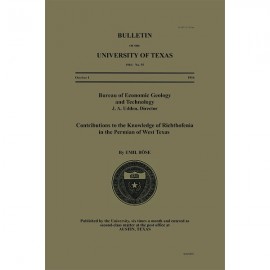Reports of Investigations
-
Books & Reports
- Reports of Investigations
- Guidebooks
- Udden Series
- Geological Circulars
- Down To Earth
- Atlases of Major Oil and Gas Reservoirs
- Texas Memorial Museum Publications
- Environmental Geologic Atlas of the Texas Coastal Zone
- Mineral Resource Circulars
- Other Reports
- Seminars and Workshops
- Handbooks
- Submerged Lands of Texas
- Symposia
- Annual Reports
- Open File Reports
-
Maps & Cross Sections
- Thematic Maps
- Miscellaneous Maps, Charts & Sections
- Geologic Atlas of Texas
- STATEMAP Project Maps
- Geologic Quadrangle Maps
- Cross Sections
- Highway Geology Map
- Energy and Mineral Resource Maps
- Shoreline Change and Other Posters
- Wilcox Group, East Texas, Geological / Hydrological Folios
- Bouguer Gravity Atlas of Texas
- River Basin Regional Studies
- Featured Maps
- Posters
- Teachers & the Public
-
Geological Society Publications
- Gulf Coast Association of Geological Societies
- Alabama Geological Society
- Austin Geological Society
- Corpus Christi Geological Society
- Houston Geological Society
- Lafayette Geological Society
- Mississippi Geological Society
- New Orleans Geological Society
- South Texas Geological Society
- GCS SEPM Publications
- Historic BEG & UT Series
Ecological Interpretations of Pliocene and Pleistocene Stratigraphy in the Great Plains Region
RI0029
Ecological Interpretations of Pliocene and Pleistocene Stratigraphy in the Great Plains Region, by J. C. Frye and A. B. Leonard. 11 p., 3 figs. Reprinted from American Journal of Science, v. 255, no. 1, 1957. T. Print
A free, digital version of this publication can be found on: Texas ScholarWorks
This product is no longer in stock
RI0029. Ecological Interpretations of Pliocene and Pleistocene Stratigraphy in the Great Plains Region, by J. C. Frye and A. B. Leonard. 11 p., 3 figs. Reprinted from American Journal of Science, v. 255, no. 1, 1957.
ABSTRACT
In the Great Plains the succession of gross ecological conditions through Neogene and Quaternary time may be interpreted from the stratigraphy, geomorphological history, buried soils, and fossil mollusks and plants. A mild humid climate prevailed over a late-mature erosional topography in earliest Neogene. Progressive reduction of topographic relief and lowering of the regional water table, accompanied by an almost uniform drying of the climate, followed. Semiarid, rigorous conditions existed on the constructional plain, temporarily at erosional equilibrium, at the end of the Tertiary. A sharp reversal of climatic trend accompanied by stream incision and minor alluviation marked the beginning of the Pleistocene. The trend toward humidity culminating in the Kansan, was followed by a return to the trend— pulsating and irregular but none the less distinct—of progressive desiccation. The Recent climate is judged to approach in dryness and rigor that which existed on the late Tertiary plain.
Keywords: Great Plains, Pliocene, Pleistocene, Neogene, Quaternary, climate, ecological conditions
Citation
Frye, J. C., and Leonard, A. B., 1957, Ecological Interpretations of Pliocene and Pleistocene Stratigraphy in the Great Plains Region: The University of Texas at Austin, Bureau of Economic Geology, Report of Investigations No. 29, 11 p.






